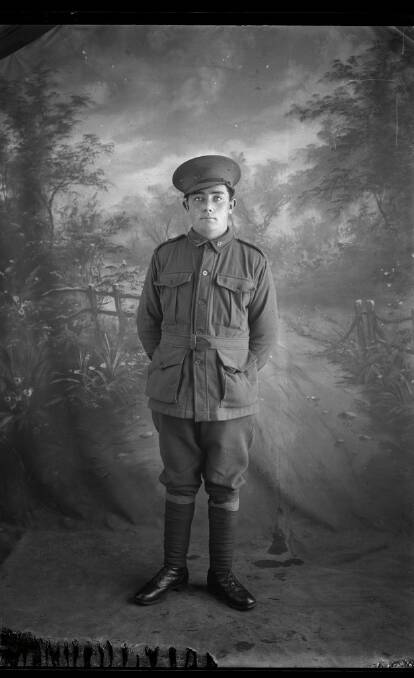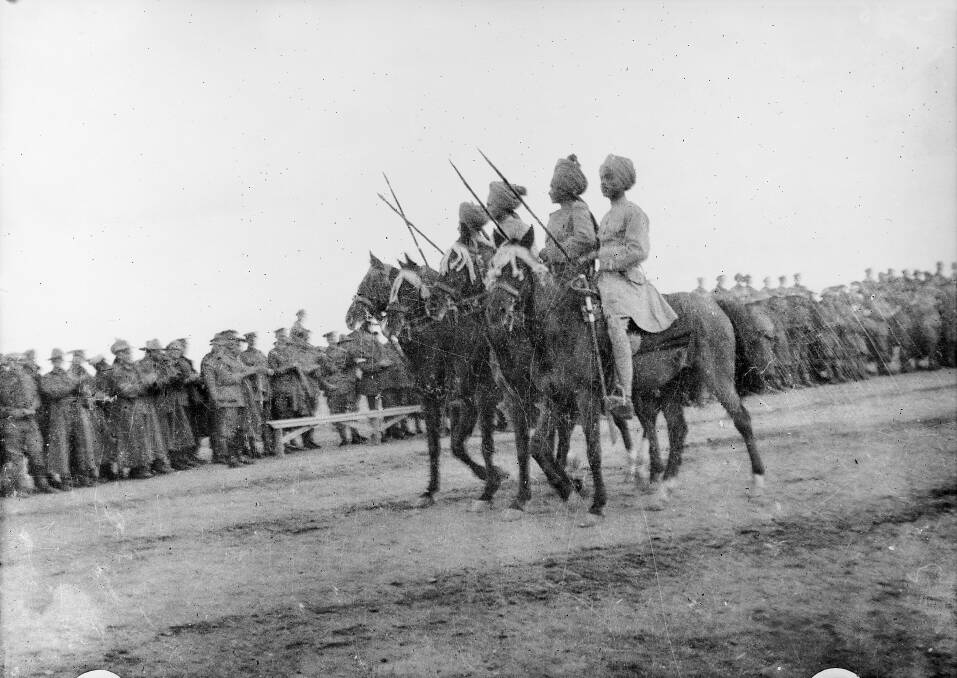Anzac DayAdvertising Feature
Tales of love and loss in times of conflict still resonate todayAdvertising Feature

Loss, grief, and bereavement are universal aspects of the human experience, whether 100 years ago or today.
During times of war, their impact is felt greatly by individuals, families and communities.
Australian War Memorial historian Meghan Adams is particularly interested in veterans' experiences and the history of grief and bereavement.
She has recorded countless stories from the First World War, among others, and one in particular - that of the Mara brothers - a harrowing tale of love and loss resonates still.
Five of the six Mara brothers of Jamestown, South Australia, enlisted to serve in the Australian Imperial Force.
Eldest son, Alfred Mara, served in the South African War. Afterwards, he wrote to say he was leaving for Canada and was not heard from again.
"The war was indeed a global conflict on a large scale, and the Mara brothers were just five men among millions who served their countries," Ms Adams wrote.
"Their story is interesting, however, in that it showcases the breadth of experiences of those who served and shows how a global conflict, at its core, is the story of people.
"Their story shows how the Great War would ... have consequences for the families, individuals and communities who felt the impact of the war on a far more personal level."
Robert Mara was the first to volunteer in 1914, followed by Walter Mara a month later.
The two were in Egypt when younger brother Clarence enlisted in 1915, to be followed not long after by twin John.
The twins' date of birth and names (Clarence John and John Clarence) would later be the source of much confusion and anxiety.
The final brother, Ernest, enlisted later in 1915.
Walter Mara served at Gallipoli, surviving the landing.
However, he later took his own life on the Western Front.
The four remaining were sent to the Western Front, where Robert was hospitalised for illness.
During the fighting near the French village of Pozieres, John and Ernest went missing, and Clarence was declared to have been killed in action.
"By this stage of the war, their family in Jamestown had one son in hospital, two sons who were dead and two more sons who had quite possibly shared that fate," Ms Adams wrote.
In 1917, Robert died of pneumonia, while the whereabouts of John and Ernest were still unknown.
Later that year, the Mara family received a telegram revealing Clarence and Ernest were prisoners of war in Germany.
As this news had taken so long to reach their mother, she had endured months of uncertainty about their fates.
"With the discovery that Clarence and Ernest were prisoners of war, it became clear that it was, in fact, Private John Mara who had been killed in action," Ms Adams wrote.
His body was never recovered.
The brothers remained POWs until Armistice Day, after which they were repatriated to England and arrived back in Australia in 1919, returning to a far emptier home.
"Of the more than 400,000 Australians who enlisted to serve in the First World War, just five of them were Mara boys. Of the more than 60,000 who never made it home, just three of them were Mara boys. Of the five sons the Mara family had to give, all five of them enlisted. Their contribution was one hundred per cent. One took his own life, one died of illness, one was killed in action, and two became prisoners of war," Ms Adams wrote.
While the contribution may seem inconsequential in light of Australia's greater losses, Ms Adams said it had significant consequences for the family and wider community.
"It was not unusual for families to have multiple members serving or killed; what makes it unique is the extent of the loss experienced," she said.
"The confusion over the two brothers' names, you can imagine the extreme anxiety over not knowing."
Communities also felt these losses. "In these small communities during the First World War in Australia, there were not always a lot of people living there. They were tight-knit, and people knew each other, so when someone was killed in action, this was big news for everyone," she said.
"Families were left ... without breadwinners, family businesses would suffer, and communities would find people missing from sports teams and everyday life. Absences were really felt and especially more so when they didn't know what had happened to an individual."
Absences were really felt and more so when they didn't know what had happened.
"Operations like the Red Cross Wounded and Missing Bureau were established during the war to help people find out what had happened to their next of kin.
"Often information passed on was scant, the message might be passed on they were killed in action, but families would want to find out what happened, where they are buried to be able to cope and move on."
Stories like that of the Mara brothers still have impact and relevance today, Ms Adams said.
"It's impossible for anyone to read their story and not feel moved by that," she said. "If you can place yourself in the shoes of the Mara family and imagine what that loss and anxiety must have been like, getting letter after letter with awful news.
"Even though the scale of loss in the First World War was unlike anything seen since, the experience of loss remains the same for families today.
"For current serving soldiers, their families still feel that loss or anxiety when their loved one is in a situation that can be life or death.
"Remains are often returned now, so families have a place they can go and grieve, but that loss is still immense."
Ms Adams also said that during her time at AWM, she'd come across the notion of generational loss.
"I see members of the public come to pay respects and mourn. Sometimes when they visit, they are still feeling the loss of relatives who had been killed during war, as stories of grief and loss are handed down through families.
"They might never have met them, but they still come here for closure."
Occasions like Anzac Day become an opportunity to reflect on the stories of the Mara brothers and many others like them.
"These stories remind us that war at its core has a human element, it involves real people, real families and real lives being changed and impacted in different ways by conflict.
"There are incredible stories of bravery and sacrifice, but it's important to remember that there are real and often sad outcomes. When people mark one minute's silence, it's important to remember what war has cost people and families."
Read more at awm.gov.au/articles/blog/remembering-the-mara-brothers.
A day to remember and reflect on the cost of war for us allAdvertising Feature

Everyone knows Anzac Day falls on April 25 each year - it is, after all, a national public holiday. But what many may not know is how commemorations have evolved over the years and how the day has fallen in and out of favour. Australian War Memorial senior historian Craig Tibbitts, who has been with the AWM for 24 years, explained the history and origins of the day.
"It's to commemorate the anniversary of the Australian and New Zealand Army Corps landing on the Gallipoli Peninsula on April 25, 1915, for the AIF troops, their first campaign of World War I," he said. "It was extra significant for Australia because by now we were a Federation [1901], a single nation fighting alongside our New Zealand brethren."
As we know, the campaign was filled with sorrow due to its failure and heavy casualties throughout its eight-month duration. "Good people were lost," Mr Tibbitts said. "And it's really to mark that event and those lost during that campaign."
Even as early as 1915, attempts were made to create an Anzac Day, but there was a lot of confusion surrounding it, Mr Tibbitts said. "We didn't have Australia Day back then as such, we didn't have a national day, and what people tried to create was mixed in and merged with Labor Day and Eight Hour Day.
"In some events, there was confused messaging about various pageantry parades and marches, and some even included army recruiting drives as well," he said. There was a mixture of sentiments, from nationalist patriotism to fundraising for the wounded.
In 1916, however, Chaplain David Garland, an Anglican clergyman and a military chaplain in Queensland, pioneered what would become the basis of the Anzac Day we are familiar with today. The troops were no longer on Gallipoli, having moved on to the Western Front.
Chaplain Garland had firm ideas that Anzac Day should be commemorated throughout Australia uniformly, and he formed a committee to divert from the chest-thumping of former pageantry and fundraising-based events. He felt it should be seen as more of a sombre religious event, and on April 25, 1916, the day was marked in Australia, as well as in Egypt and Britain by serving troops.
About 2000 Australian and New Zealand servicemen marched in London to a service held in Westminster Abbey and attended by the King and Queen. In Egypt, the event adopted a mix of solemnity and light-heartedness, with a short service followed by the rest of the day spent in sports and entertainment.
"There have always been arguments about what it should and shouldn't be, about the right mix of solemn commemoration and leisurely activities," Mr Tibbitts said. "And how religious it should be and whether shops should be opened or closed. But compromises were worked out, and you end up with a mix of solemn functions in the morning, like a dawn service, reading of the ode, veterans marches and addresses, which then give over in the afternoon to veterans reunions where they let their hair down a bit and play things like two-up."
By 1919, the importance of the day was universally recognised, and in 1927, the day became a public holiday. "Anzac Day's popularity has gone up and down over the decades," Mr Tibbitts said. "There was a lot of anti-war sentiment in the 1960s, '70s, and even into the '80s, but then by the 1990s and to the present day, there's been a resurgence in interest and popularity.
"That really culminated in 2015, the centenary of the landing, when there were huge crowds and public support."
While there are no longer any living original Anzacs, the day has expanded its scope and become an occasion to acknowledge veterans from all wars.
It is difficult to predict how the day might change and evolve into the future, but Mr Tibbitts said the important aspect was to remember. "As we know, war is a terrible thing, the loss of life and destruction, and even for those who survive," he said. "Wars are going on now, and we must always remember the cost of war. I hope we will never see in Australia the scale of loss we saw over two world wars [100,000 lives].
"But the world is an increasingly dangerous place, and sometimes it looks like we are heading down the path of another world war. We want to remember those who paid the ultimate price. It's important for all Australians to appreciate and understand, but no one should be dictated to or told how they should think about it. There are always going to be differing views, but you need to make up your own mind about how it is important to you."


